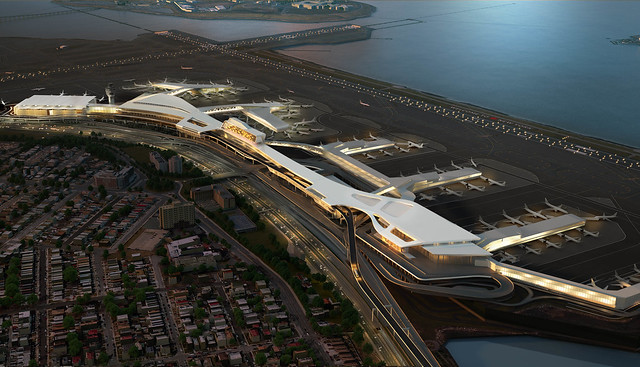
Transportation Alternatives has expanded on the RPA’s modest call for a pedestrianized few blocks of 14th St.
There’s been a low-level drumbeat, sometimes crescendoing, over the past decade regarding Manhattan’s river-to-river cross streets. Vision42, an on-again/off again advocacy group, has long pushed for a car-free 42nd Street devoted to light rail and people, and a plan put forward by the Bloomberg Administration and doomed by recalcitrant Community Boards would have converted 34th St. into a Transitway primarily for the benefit of tens of thousands of daily bus riders who use this popular corridor. Now, the looming L train shutdown may give advocacy groups and the city a third bite at the crosstown apple.
Although the L train shutdown isn’t likely to begin before 2019, the MTA has to announce its plans later this year, and various groups are jockeying for a voice at the table. Although I think the effects of the shutdown have been blown out of proportion, the city’s and MTA’s options for dealing with the shutdown are both obvious and limited, as I explored in January. I offered then a seven-point plan to address the shutdown including expanding all nearby and connecting subway service while turning the Williamsburg Bridge into a bus-only route, and now Transportation Alternatives has taken this idea one step further. Building on a proposal from the RPA, the TA wants 14th St., from river to river, to be a peopleway, both during the L train shutdown and after.
The TA held a launch event for this idea last night after issuing a release with the general outline of the plan last week. Here is their thinking:
Right now, approximately 50,000 people use the L train every day within Manhattan alone. In 2015, average weekday bus ridership on the M14 line was 32,868 commuters. Given that the M14 will not be able to meet the demand resulting from an L train shutdown, we need to transform 14th Street into a PeopleWay, a public transit corridor that maximizes bus ridership and facilitates an increase in biking and walking to accommodate stranded weekday commuters.
Private motor vehicle trips are the least efficient form of travel in terms of capacity. The City would not be able to cover the loss of the L train with car trips without tearing down buildings to create additional street space. Sidewalks, protected bike lanes and dedicated bus lanes carry 15 times as many people as lanes for private cars. A combination of two-way protected bike lanes, dedicated bus lanes and expanded sidewalks could double the corridor’s current capacity, serving up to 24,500 people per hour or more than 500,000 people per day, according to figures from NACTO.
The Regional Plan Association has proposed closing 14th Street to private cars between Irving Place and Sixth Avenue, with expanded bus service. We share the vision that the City should turn the entire 14th Street corridor into a “PeopleWay,” replacing existing private vehicle traffic and suspended subway travel with bus rapid transit, bikeways, and more sidewalk space. We believe that the City should not only create this PeopleWay to meet the challenges of the L train shutdown, but also make it permanent as part of the effort to create a more sustainable and efficient transportation system for New York City’s future.
The RPA’s plan is far too modest, and it’s obvious the problems that would arise by closing just an avenue and a half to cars. But a river-to-river repurposing of 14th St. during the L train shutdown, as the TA has proposed, would be truly transformative. Buses would run frequently and smoothly along the path of the L train, and the MTA and DOT could reconfigure peak-hour routes off of the Williamsburg Bridge and up or down 1st or 2nd Avenues to provide a busway from Brooklyn as well.
It’s no small task to implement an idea like this. Residents concerned primarily with door-to-door private car access who suddenly forget how to walk a block or two have been loud, vocal opponents of these types of ideas, but at some point before 2019, the city is going to have to do something to address the mobility challenges and L train shutdown will bring. A Peopleway is a prime opportunity to show this idea — handing city streets over to transit and pedestrians and bikers — can not only work but be very successful. Business owners along the route who recognize that their customers walk and use transit are on board. Now it’s up to the city to join the plan. If, or when, it works, the Peopleway is an idea that could just stick around for a while.

























 For certain reasons, The New York Times seems to bury its urban policy editorials on Saturdays, and a pro-congestion pricing missive published on May 21st continued the trend. I didn’t have an opportunity to write it up last week, but for a few reasons, it’s worth revisiting. It’s a ringing endorsement of the Move New York plan, but I worry that supporters are putting too much hope on a plan that, when judged on its merits only, is very worthwhile but isn’t the single silver bullet it is often made out to be.
For certain reasons, The New York Times seems to bury its urban policy editorials on Saturdays, and a pro-congestion pricing missive published on May 21st continued the trend. I didn’t have an opportunity to write it up last week, but for a few reasons, it’s worth revisiting. It’s a ringing endorsement of the Move New York plan, but I worry that supporters are putting too much hope on a plan that, when judged on its merits only, is very worthwhile but isn’t the single silver bullet it is often made out to be.